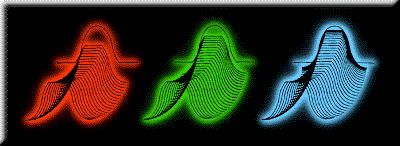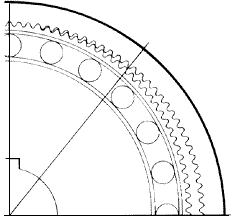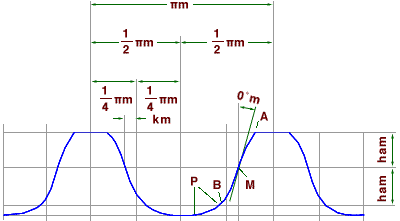

|
|
Home > Reference > Advantages : |
|
 PAGE: "Reference | The 'S' Series Tooth Form :: Harmonic Drive LLC"
PAGE: "Reference | The 'S' Series Tooth Form :: Harmonic Drive LLC"|
|
|
|
Often when you see an "S" in our model designations, such as RFS, RHS, CSF, or SHF, we are telling you that our patented gear toothform is being used. This new tooth profile has been developed through theoretical modeling and the extensive use of FEA/CAD tools which have only become available in the last few years. These powerful tools have brought new technical understanding to the harmonic gearing mechanism and at the same time allowed us to improve our design, resulting in greatly improved performance.
The CAD graphic below of teeth engaging shows how the new S tooth was designed to permit multiple tooth engagement. This feature brings the advantages of--

Figure 1Exactly what is this new tooth profile, and how does it provide these advantages? Before answering those questions we need a brief review of the original, conventional Harmonic Drive® strain wave gearing. In theory, only two gear teeth were engaged at any time in this system; one gear tooth at each end of the major axis of the flexspline ellipse. In fact, cup type gear have multiple teeth in contact, however, when torque is applied additional teeth come into contact. With multiple teeth engaged, the amount of torque that can be transmitted is increased. But, that torque increase comes as a result of lower torsional stiffness in the low torque region. We can see this in the hysteresis curves (Figure 2) that show torsional stiffness. (Also called wind-up in some literature.) The standard tooth has a larger amount of torsion (twist) in the low torque region, giving the curve a pronounced parabolic shape. As more teeth become engaged the stiffness increases.
Figure 2When this condition was studied, the natural question was, " Can we design a gear system where by design we have increased tooth engagement?" The CAD graphic of Figure 1 shows the results of the mathematical and kinematic studies that were conducted. In the graphic, which is like a multiple exposure photograph, the progression of engagement can be seen for three gear teeth. Engagement starts at the tip of a tooth and continues until there is full tooth engagement. Further studies have shown that the total angle of engaging teeth for the new "S" series toothform is about double the conventional tooth form designs.

Figure 3The original toothform has an involute curve profile that is common to most spur gears. The new "S" Series toothform does not use the involute curve, instead it uses a series of pure convex and concave circular arcs created to match the loci of engagement points dictated by theoretical and CAD analysis. The tooth profile below shows a picture of the geometry. (For a more complete explanation of this geometry you can ask us for a copy of the ASME conference proceedings paper referenced at the end of this article.)

Figure 4Notice a very important design change with this new "S" tooth profile. See how substantial the root fillet radius is? This increased root fillet radius makes the "S" Series tooth much stronger than an involute curve gear tooth. The root fillet radius is a focus for stress concentration and fatigue due to bending. By increasing the radius, a stronger tooth is created, a tooth that will resist higher bending (tension) loads, while maintaining a safe stress margin. The increased root fillet radius also has the effect of increasing the root thickness of the tooth. With a greater root thickness the tooth has a larger load capacity based on acceptable shear stress. Together, both of these factors make a much stronger tooth that is more rigid and less likely to bend. From this design result comes the nearly doubled momentary peak torque ratings of the "S" Series products. This stronger tooth and the increased engagement angle is why the torsional stiffness of the "S" Series is now twice as large as conventional gearing. You can see this in the curve for "S" Series torsional stiffness (Figure 2 ). In addition to having double the stiffness, the curve is practically a straight line, providing a linear stiffness relationship rather than the parabolic shape of conventional strain wave gearing. With the same rated load torques, the "S" Series life has double the life of conventional units. The larger angle of engagement distributes the radial forces on the bearing over this larger surface area. This results in an increase in the life of the bearing by a factor of 2.3! We have torque specifications for momentary and repeated peak torques. Because of the new tooth profile in the "S" Series, both of these torque specifications have been doubled. This provides a compact package with an even higher packaging ratio of torque per cubic inch, and with lower weight for those applications where space and weight are at a premium. With all of this improvement in load capacity, the efficiency of the "S" Series drive units has been maintained at the same levels of previous Harmonic Drive® gears. Even though by design more teeth are engaged, the rolling action of engagement maintains a high efficiency, in the range of 60% to 90% depending upon the load, speed and lubrication. We think our new "S" Series products with our new tooth profile brings a quantum improvement to Harmonic Drive® gears. If you would like to discuss this further, please give us a call or send us an email message. We enjoy talking about this technology and would be glad to answer any questions that you may have. Reference: Y. Kiyosawa and S. Ishikawa, "Performance of Strain Wave Gearing Using a New Tooth Profile", ASME International Power Transmission and Gearing Conference, Vol. 11, Book No. 10288B1989. |